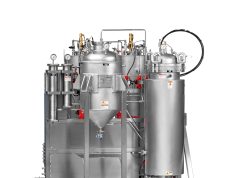When engineers learn to design new products, their education places a strong emphasis on proactive engineering and design measures aimed at eliminating or mitigating the impact of component obsolescence during production and sustainment. But this focus on staving off obsolescence results in comparatively little education on what to do when, in spite of your best endeavors, components are not available when you need them. It may be due to a stock shortage, new developments in technology, or market demand. It may be a component, made by only one qualified manufacturer who is confronted by an unforeseen fire or global event. Whatever the reason, sooner or later a component you need will no longer be available through authorized component distributors in time to meet your production schedule. And you’ll have to find a way forward.
If you are designing high-reliability, life-critical products that require vigorous and costly testing before production and are intended to stay in use for years or even decades, the issues of obsolescence and procurement risk management are inevitable. Technology will evolve throughout the life of the program, so you need to understand and plan for the complex and unpredictable process of sourcing obsolete components.
When you can’t procure a component from an authorized distributor, here are some of the things that are crucial to know.
Lessons for the Electronic Components Aftermarket
The Volatility of the Aftermarket Makes it Difficult to Navigate
Sourcing electronic components through authorized distributors is pretty straightforward. You have to manage your production and understand the fail rate of your products in order to make sure you’ve ordered the necessary percentage of replacements for repairs. You have to plan for your production rate and sustainment schedule. If you do that, you’re generally fine.
But when fast-paced changes in technology start chipping away at the component needs of your legacy programs, things become less clear and predictable. How do you plan in a volatile market with distributors that create confusion around market availability by posting the same stock under multiple subsidiary company names? How do you handle lead times that aren’t always accurate? The vagaries of the Aftermarket can leave Engineers vulnerable to shortages and line down situations.
Navigating the Aftermarket takes knowledge and experience that most engineers simply don’t have. That’s why it’s advisable to partner with a Certified Independent Distributor who specializes in sourcing components from non-authorized sources. Certified Independent Distributors specialize in tracking market trends. They understand the risks of aftermarket sources and know the proper procedure for vetting the company’s history and certifications. Certified Independent Distributors represent a low-risk, low-liability approach to procuring components.
Procurement specialists who understand the market and know what they’re looking for can help you stay ahead of procurement risk, long lead times, and component shortages.
Online stock listings for a component may not accurately reflect its real-time availability
You might think you can gauge the availability of a component through a quick check of what’s available for online purchase. If companies list a component in stock, you’re probably good for a while, right?
Unfortunately, there’s no guarantee that even reliable component suppliers’ sites are completely up-to-date in their listings. You need to confirm that inventory. And you need to know the lead time – don’t assume the availability of a part means it can be quickly delivered. And if you’re not closely following the component market, you may not be aware of increasing demand that may deplete those sources sooner than you’d expect.
Specialists in procuring securely and safely from the global market have the tools to track what real-time stock actually exists vs. what is listed on the Internet. But you can’t accurately gauge the availability of a component by spending an hour or two online.
Certified independent distributors remove counterfeits from the supply chain
Counterfeits are a constant danger in the open electronic components market. It’s something you need to watch out for, so you need to know how to vet vendors and what testing is required to assure the authenticity of components. Certified independent distributors have counterfeit avoidance plans to make sure they never pass a counterfeit on to their customers.
Not only does working with such a distributor protect you from liability – it also helps to protect everyone else. If a certified distributor with a counterfeit avoidance plan discovers a counterfeit, they don’t just send it back to the source – they report it and destroy it. This makes them an important part of the fight against counterfeit components.
Independent distributors work best if given life-critical information on your program
Components procured through the open market need to be tested if there’s not a proper chain of custody. But since tests add cost, there can be a tradeoff on how much testing is necessary. If your component is going into a transport plane’s coffeemaker, well, some risk of failure may be acceptable to keep costs down – all that’s going to happen is that someone won’t get their coffee.
But if that component is going into something life-critical, like a transport plane’s flight control system, you need complete assurance that it won’t fail. For those components, you need a distributor with the AS9120 and AS6081 certification indicating they have a quality management system to securely source your components and have them tested at a government-approved AS6171 test facility.
That’s why you should inform independent distributors whether the component will be used in a life-critical application and what your quality requirements are for the program. If it’s not life-critical they won’t need to do as many costly tests. But if they don’t have that information they would rather err on the side of more testing for everyone’s safety.
FAQ
Can I design out all risk of obsolescence?
This depends in part on how long the application you’re designing will be in use. For something that will only be in service for a year or two, careful design choices can save you from the concerns of obsolescence management. If this is for a program meant to continue for a decade or two, on the other hand, there is very little likelihood that you can design out all the obsolescence risks.
What components are most likely to become difficult to procure?
The more companies there are that manufacture a component, the less likely it is that you will have difficulty procuring it when needed. The real danger comes with those components that only have a single qualified manufacturer. Once they decide to obsolete a component, it is only a matter of time before there are no authorized distributors to sell it.
How reliable are online listings for aftermarket components?
Not very. Some companies will list components not because they have them but because they believe they can source them. And sometimes reputable sites will have listings from disreputable companies, including some blacklisted by the government, simply because they are not equipped to vet their sources. So it’s a bit of a crapshoot.
How do I lower the risks in procuring components through non-authorized distributors?
Plan ahead for future obsolescence and procurement issues by partnering with Independent Distributors that are certified reliable sources for open market components. Vetting certified independent distributors now will smooth the process later on.
Can I learn to navigate the perils of the open market for electronics components?
Educated engineers can certainly learn the basics of the open market. They can research the best sources for components, learn how to track market trends, and either bring testing in-house or utilize a DOD-approved AS6171 testing facility. But this takes a considerable investment of time and energy that takes away from your other duties.
Conclusion
If you design for programs that will run for many years or decades, obsolescence and procurement management are unavoidable.
You should always have the backup plan of a vetted electronic parts supplier in case of future shortages or obsolescence. Planning now is better than panicking later.
Sourcing open-market components through certified independent distributors lowers risk and liability.
Cursory online research cannot give you an accurate sense of future component availability.
Life-critical applications require a greater degree of caution when procuring open-market components.
The Final Lesson: Partnering with Secure Components Means Getting the Components You Need
We can’t teach you everything we know about obsolescence management and hard to find components in one blog post, but that’s okay. Because all you really need to know is that:
- Secure Components is a trusted partner for procuring reliable components.
- Secure Components can help you proactively plan for obsolescence by monitoring your BOM in real time.
- Secure Components is AS9120B certified and AS6081 certified, so you are assured that we have stringent systems in place suitable for life-critical applications.
Don’t put off protecting your programs. Contact Secure Components today!










